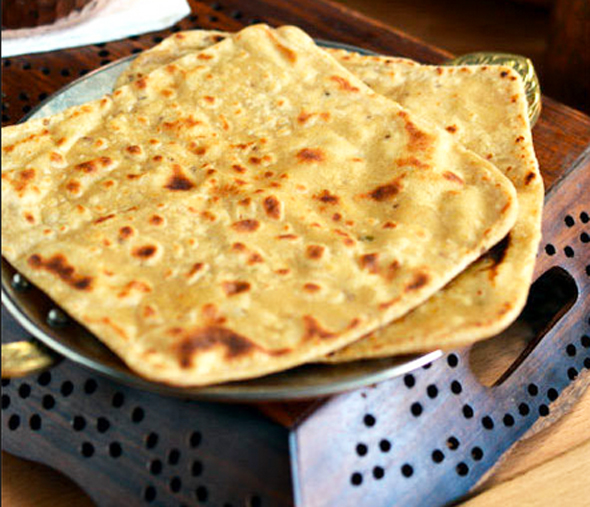Mama’s Punjabi Recipes: Loon-Mirch Da Parantha (Salt-Pepper Wheat Pancrusted Flatbread)
Saved under Community, Current Stories, Recipe Corner
Tags: Baytown, Clear Lake, Cypress, Desi news, Greater Houston, Houston, Houston Desi news, India, Indian American community, Indian News, Indians in America, Indo-American News, Katy, Loon Mirch da Parantha, Mama’s Punjabi Recipes, NRI, pearland, Shakuntla Malhotra, south asia, South India, Sugar Land, Texas, USA
By popular demand from many readers – and especially some younger ones – this is a reprint of Mama’s Loon-Mirch da Parantha recipe, but with some additional information and directions.
By now, every Indian probably knows what a parantha is and immediately associates it with Punjabi cuisine. Other cuisines have tried to copy them and make their own versions of paranthas though with varying results, but certainly not the stuffed ones, and are often thinner and greasier than the Punjabi originals.
Pre-cooked paranthas are also sold under many brand names in the frozen food aisles of Indian grocery stores. So popular are they that lately even some brands of wheat flour makers have gotten into the business of making ready-to-eat frozen paranthas. You can find frozen paranthas that are plain, ajwain (carom seeds), methi (fenugreek), spinach, and others stuffed with aloo (potatoes), paneer (Indian cheese), piyaaz (onions), gobi (cauliflower) and a few more varieties. But, as one can expect, most of them are often stingy with their fillings!
Paranthas can be a meal by themselves, sort of like a pizza. But when all else fails and there is no time to make any stuffing, you can always fall back on the simple paranthas with just the right amount of loon (salt) and lal mirch (red pepper) to make a meal with plain yogurt or even a clump of butter melting on top of the crispy, browned top skin.
I remember that when my two sons were young and growing up in London, England, on cold wintery days, when it was difficult to get out to the stores, they would ask for a loon-mirch parantha with a little dab of butter sitting together at the kitchen table! This type of parantha goes particularly well with any plain daal (lentils) that hasn’t been fried and so makes for a good, quick meal.
Ingredients:
500gm kanak (gehon) ka atta (wheat flour)
2 tbsp tael (olive oil or vegetable oil)
1 1/2 cups pani (water)
1/4 tsp namak (salt) per parantha
1/4 tsp mirch (red pepper) per parantha
1/4 tsp ajwain (carom seeds) per parantha – optional
Directions:
1. Pour the atta into a wide-mouthed bowl (stainless steel is best). Form a small crater and slowly pour the water in while kneading the dough with your hand till it becomes a nice, tender but firm ball. Make sure that the dough is not hard or too soft, thin or stringy when pulled. It shouldn’t stick to the hands or the bowl. Add a teaspoon of oil and knead in some more.
2. Dab the surface of the ball with a little water to keep it moist, cover the bowl and set aside for an hour. You can then place it in the fridge for longer duration. If the dough is too hard, the parantha will also be hard.
3. Grease your hands with a dab of oil. Pinch off a small amount of dough and roll it in the palms of your hands into a 2-inch round paada (ball).
4. Coat the counter top with some dry atta, then roll the ball out with a pin into a 4 inch disc.
5. Throw in the salt, pepper and ajwain, then gather off the ends off the dough in pleats with a pinch and then roll into a ball again. The ajwain is optional but helps with digestion and gives additional flavor.
6. Carefully roll out the ball into an 8 to 10 inch disc, ¼ inches thick, trying not to put a tear in the dough.
7. Put a small dab of oil on a hot tava (hotplate or skillet) and place the flattened disc on. When it puffs a bit and turn color, turn the pancake over. Turn the heat to medium low. Put another dab of oil on the tava and then turn it over again till it is fully cooked. Do NOT keep pressing dough on the pancake as this will only make the dough stick together. A well-made parantha will actually puff up!
8.These paranthas are best served hot with butter, plain yogurt, daal (lentils).
MAMA’S TIP OF THE WEEK: ROAST SOME SAUNF (FENNEL SEEDS) FOR FLAVORING AND TASTE
Most often after a meal in an Indian restaurant, you can pick up some dried saunf (fennel seeds) as you pass the cashier’s counter. You can chew on them as you leave as they are considered a digestive and also help to clean up any food breath.
At home, you can go one step further by dry roasting the fennel seeds on a tava (flat plate) for a few minutes and then storing them in a sealed glass jar. The roasting will bring out a nice aroma that will cleanse the air of odors. If you are inclined, take the roasted seeds and crush them in a mixie into a powder. You can use this powder as flavoring when making tea or in preparing sweets or other Indian dishes.

Shakuntla Malhotra is a skilled cook of Punjabi dishes made in the old-fashioned style that she learnt as a young woman in her ancestral home in Lyallpur (since renamed Faisalabad), India before it became part of Pakistan after the Partition in 1947. People have often admired her cooking for its simplicity and taste that comes with each mouthful. Even in her mid-eighties, she continues to cook daily and agreed to share some of her delectable Punjabi recipes

